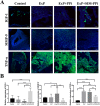Identification of Genes Differentially Expressed in Simvastatin-Induced Alveolar Bone Formation
- PMID: 31131344
- PMCID: PMC6524672
- DOI: 10.1002/jbm4.10122
Identification of Genes Differentially Expressed in Simvastatin-Induced Alveolar Bone Formation
Abstract
Local delivery of simvastatin (SIM) has exhibited potential in preventing inflammation and limiting bone loss associated with experimental periodontitis. The primary aim of this study was to analyze transcriptome changes that may contribute to SIM's reduction of periodontal inflammation and bone loss. We evaluate the global genetic profile and signaling mechanisms induced by SIM on experimental periodontitis bone loss and inflammation. Twenty mature female Sprague Dawley rats were subjected to ligature-induced experimental periodontitis around maxillary second molars (M2) either unilaterally (one side untreated, n = 10) or bilaterally (n = 10). After the ligature removal at day 7, sites were injected with either carrier, pyrophosphate (PPi ×3), 1.5-mg SIM-dose equivalent SIM-pyrophosphate prodrug, or no injection. Three days after ligature removal, animals were euthanized; the M1-M2 interproximal was evaluated with μCT, histology, and protein expression. M2 palatal gingiva was harvested for RNA sequencing. Although ligature alone caused upregulation of proinflammatory and bone catabolic genes and proteins, seen in human periodontitis, SIM-PPi upregulated anti-inflammatory (IL-10, IL-1 receptor-like 1) and bone anabolic (insulin-like growth factor, osteocrin, fibroblast growth factor, and Wnt/ β-catenin) genes. The PPi carrier alone did not have these effects. Genetic profile and signaling mechanism data may help identify enhanced pharmacotherapeutic approaches to limit or regenerate periodontitis bone loss. © 2018 The Authors. JBMR Plus Published by Wiley Periodicals, Inc. on behalf of the American Society for Bone and Mineral Research.
Keywords: ANABOLICS; DENTAL BIOLOGY; GH/IGF‐1; MOLECULAR PATHWAYS–REMODELING; WNT/Β‐CATENIN/LRPS.
Figures






Similar articles
-
Thermoresponsive Hydrogel-Based Local Delivery of Simvastatin for the Treatment of Periodontitis.Mol Pharm. 2021 May 3;18(5):1992-2003. doi: 10.1021/acs.molpharmaceut.0c01196. Epub 2021 Mar 23. Mol Pharm. 2021. PMID: 33754729 Free PMC article.
-
Effect of Simvastatin Prodrug on Experimental Periodontitis.J Periodontol. 2016 May;87(5):577-82. doi: 10.1902/jop.2016.150599. Epub 2016 Jan 22. J Periodontol. 2016. PMID: 26799395
-
Effects of local simvastatin-alendronate conjugate in preventing periodontitis bone loss.J Periodontal Res. 2013 Oct;48(5):541-8. doi: 10.1111/jre.12036. Epub 2012 Dec 30. J Periodontal Res. 2013. PMID: 23278592
-
Local Application of Pyrophosphorylated Simvastatin Prevents Experimental Periodontitis.Pharm Res. 2018 Jun 25;35(8):164. doi: 10.1007/s11095-018-2444-z. Pharm Res. 2018. PMID: 29943090 Free PMC article.
-
Characterization of ligature-induced experimental periodontitis.Microsc Res Tech. 2018 Dec;81(12):1412-1421. doi: 10.1002/jemt.23101. Epub 2018 Oct 23. Microsc Res Tech. 2018. PMID: 30351474
Cited by
-
A literature review of bioactive substances for the treatment of periodontitis: In vitro, in vivo and clinical studies.Heliyon. 2024 Jan 11;10(2):e24216. doi: 10.1016/j.heliyon.2024.e24216. eCollection 2024 Jan 30. Heliyon. 2024. PMID: 38293511 Free PMC article. Review.
-
Association of higher potency statin use with risk of osteoporosis and fractures in patients with stroke in a Korean nationwide cohort study.Sci Rep. 2024 Dec 28;14(1):30825. doi: 10.1038/s41598-024-81628-z. Sci Rep. 2024. PMID: 39730536 Free PMC article.
-
Thermoresponsive Hydrogel-Based Local Delivery of Simvastatin for the Treatment of Periodontitis.Mol Pharm. 2021 May 3;18(5):1992-2003. doi: 10.1021/acs.molpharmaceut.0c01196. Epub 2021 Mar 23. Mol Pharm. 2021. PMID: 33754729 Free PMC article.
-
Quercetin Preserves Oral Cavity Health by Mitigating Inflammation and Microbial Dysbiosis.Front Immunol. 2021 Nov 26;12:774273. doi: 10.3389/fimmu.2021.774273. eCollection 2021. Front Immunol. 2021. PMID: 34899728 Free PMC article.
-
Effect of statin therapy on plasma C-type Natriuretic Peptides and Endothelin-1 in males with and without symptomatic coronary artery disease.Sci Rep. 2020 May 13;10(1):7927. doi: 10.1038/s41598-020-64795-7. Sci Rep. 2020. PMID: 32404888 Free PMC article.
References
-
- Albandar J, Brunelle J, Kingman A. Destructive periodontal disease in adults 30 years of age and older in the United States, 1988–1994. J Periodontol. 1999; 70(1):13–29. - PubMed
-
- Eke PI, Dye BA, Wei L, Thornton‐Evans GO, Genco RJ. CDC Periodontal Disease Surveillance Workgroup: James Beck GDRP. Prevalence of periodontitis in adults in the United States: 2009 and 2010. J Dent Res. 2012; 91(10):914–20. - PubMed
-
- Eke PI, Dye B, Wei L, Thornton‐Evans G, Genco R. Prevalence of periodontitis in adults in the United States: 2009 and 2010. J Dent Res. 2012; 91(10):914–20. - PubMed
-
- Hoffmann T, Al‐Machot E, Meyle J, Jervoe‐Storm PM, Jepsen S. Three‐year results following regenerative periodontal surgery of advanced intrabony defects with enamel matrix derivative alone or combined with a synthetic bone graft. Clin Oral Investig. 2016; 20 (2):357–64. - PubMed
-
- Pradeep AR, Priyanka N, Kalra N, Naik SB, Singh SP, Martande S. Clinical efficacy of subgingivally delivered 1.2‐mg simvastatin in the treatment of individuals with Class II furcation defects: a randomized controlled clinical trial. J Periodontol. 2012; 83 (12):1472–9. - PubMed
Grants and funding
LinkOut - more resources
Full Text Sources
Research Materials
